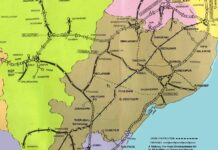Indian Railways has now highest ever total Plan capex of Rs. 2,15,058 Crores this year with Rs. 7,500 Crores from internal resources, Rs. 1,00,258 Crores from extra budgetary resources and Rs. 1,07,100 Crores for capital expenditure allocation given in the General Budget.
Indian Railways received a record outlay of Rs 1,10,055crore, of which Rs 1,07,100 crore is for capital expenditure in the Union Budget 2021-22 presented in the Parliament today.
The Gross Budgetary allocation is Rs. 37,050 cr (53%) higher than BE 2020-21. Inspite of the covid, this is remarkable vindication of the progress being made being undertaken Infrastructure projects in Indian Railways.
With this increase in Capex, Indian Railways will be the driver of Indian economy. The thrust of Annual Plan 2021-22 is on infrastructure development, throughput enhancement, development of terminal facilities, augmentation of speed of trains, signaling systems, improvement of passengers/users’ amenities, safety works of road over/under bridges etc.
The following plan heads have been allotted highest ever outlays in BE 2021-22 –
(₹in cr)
| Planhead | BE 2020-21 | BE 2021-22 | Increase over BE 2020-21 |
| New Lines | 26971 | 40932 | 52% |
| Doubling | 21545 | 26116 | 21% |
| Traffic Facilities | 2058 | 5263 | 156% |
| ROB/RUBs | 6204 | 7122 | 15% |
National Projects of Jammu & Kashmir, Himachal Pradesh, Uttarakhand and North Eastern region have been allocated highest ever outlay of Rs 12,985 cr. in BE 21-22 against the RE 20-21 of Rs 7535 cr i.e. increase of 72%..Rs.37,270 cr of GBS allocated for investment in PSU/JV/SPVs, with allocation for DFCCIL of Rs. 16,086 cr, NHSRCL of Rs. 14,000 cr and KMRCL of Rs. 900 cr.
Source wise details of BE 2021-22 compared with BE 2020-21 is shown in the following table –
(₹in cr)
| Source | BE
2020-21 |
BE 2021-22 |
| Gross Budgetary Support | 70250 | 107300 |
| Internal Resources | 7500 | 7500 |
| Extra Budgetary Resources | 83292 | 100258 |
| Total Capex | 161042 | 215058 |
Intense monitoring, better management and engagement with all the stake holders is ensuring that work is going on at unprecedented speed at the project sites now. Some projects will be commissioned by March 2021 are Redevelopment of Gandhinagar & Habibganj stations, Ahmedabad – Botad Gauge Conversion (170 km), Pilibhit – Shahjahanpur Gauge Conversion (83 km), Utretia – Raebarelli Doubling (66 km), Ghazipur-Aunihar Doubling (40 km), Ajmer – Bengurgram Doubling ( 47 km), and Nirmali – Sairagarh New Line including Kosi bridge (22 km). Key Railway Electrification projects that are also expected to be completed by March 2021 include: Mumbai – Abu Road, Mumbai – Ratnagiri,Howrah-New Cooch Behar section via Malda, Connectivity to Pipava Port , Ratlam/Mathura-Jaipur and Pune – Satara, Sonipat –Jind.
Last Financial year Indian Railways faced unprecedented Covid related challenges. Passenger services had to be stopped to prevent the spread of the virus. Indian Railways, however, kept the national supply chain running and moved great many number of migrants in the most adverse conditions.
The lockdown period was used as an opportunity by the Railways to complete more than 200 critical maintenance projects including massive track maintenance exercise, overhauling the freight business and fast tracking of the ongoing infrastructure projects like Dedicated Freight Corridors, J&K and North-East connectivity etc. In the post lockdown phase, remarkable revival in IR’s freight loading has been observed especially in the last 5 months, which shows the economic revival in the country as well as modal shift to Railways. This is due to doubling of average speed of freight trains from 23 kmph to 46 kmph, various tariff and non-tariff measures, as well as a first time ever “Freight Business Development Portal” for online booking of freight. The year is likely to close with higher loading over last year.
It may be noted that Indian Railways has prepared a National Rail Plan (NRP) for India-2030. This will be for a future ready Railways, wherein infrastructure will be created by 2030, which shall be able to cater to the demand till 2050. NRP which identifies demand and required capacity augmentation needed till 2030 also lays focus on retrieving the modal share for IR to the level of 45% by 2050 with ultimate aim to reduce logistic cost of the economy.
In the budget, it was announced that Western Dedicated Freight Corridor (DFC) and Eastern DFC are expected to be commissioned by June 2022. Further, the Finance Minister proposed the following additional initiatives to be taken up:
1. The Sonnagar – Gomoh Section (263.7 km) of Eastern DFC will be taken up in PPP mode in 2021-22. Gomoh-Dankuni section of 274.3 km will also be taken up in short succession.
2. Future dedicated freight corridor projects namely East Coast corridor from Kharagpur to Vijayawada, East-West Corridor from Bhusaval to Kharagpur to Dankuni and North-South corridor from Itarsi to Vijayawada will be undertaken. Detailed Project Reports will be undertaken in the first phase.
3. 100% electrification of Broad-Gauge routes will be completed by December, 2023. Broad Gauge Route Kilometers (RKM) electrified is expected to reach 46,000 RKM i.e., 72% by end of 2021 from 41,548 RKM on 1st Oct 2020.
While Focusing on Passenger Convenience and Safety, the budget has also proposed Introduction of the aesthetically designed Vista Dome LHB coach on tourist routes to give a better travel experience to passengers and provision of indigenously developed automatic train protection on High density network and highly utilized network routes of Indian railways. This system minimized the possibility of train collision due to human error.









































